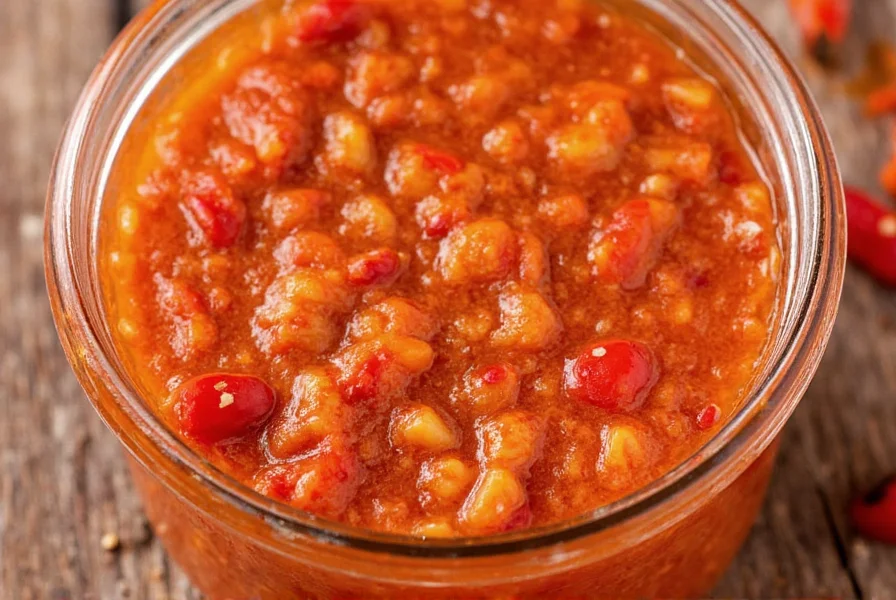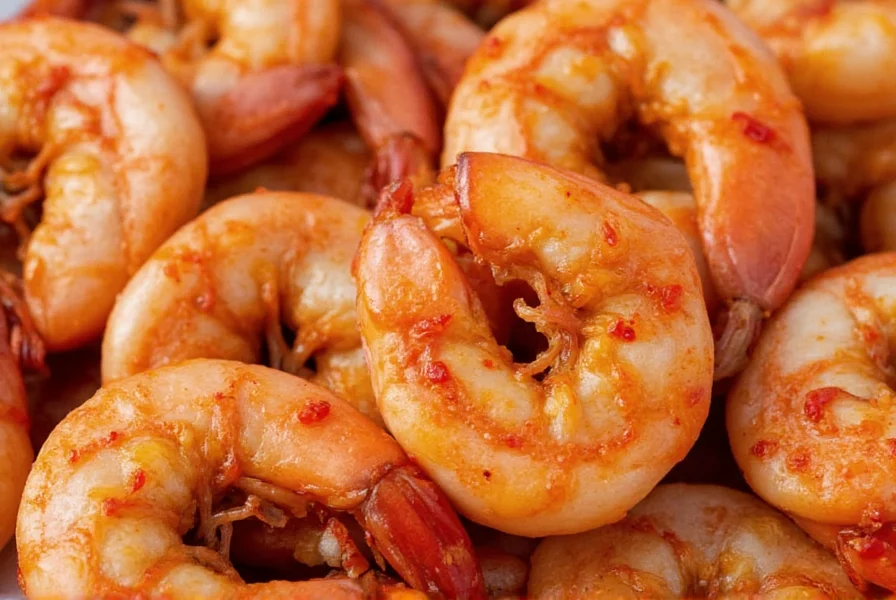Understanding this essential pantry staple can transform your cooking. This comprehensive guide explores everything you need to know about incorporating chili garlic paste into your culinary repertoire, from its distinctive characteristics to practical applications that elevate everyday meals.
What Makes Chili Garlic Paste Unique
Chili garlic paste stands apart from other hot sauces through its coarse texture and balanced flavor profile. The traditional recipe combines fresh red chili peppers (typically Thai or cayenne varieties), minced garlic, vinegar for preservation and tang, and salt. Some commercial versions include sugar or other seasonings, but purists prefer the simple four-ingredient formula.
The magic happens during the fermentation process, which develops complex flavors while preserving the vibrant red color. Unlike smooth hot sauces, authentic chili garlic paste maintains visible garlic chunks and chili flecks, creating both visual appeal and textural interest in dishes.

Practical Culinary Applications
Chefs and home cooks value chili garlic paste for its versatility across multiple cuisines. Consider these effective ways to incorporate it into your cooking:
- Marinades: Combine with soy sauce, ginger, and sesame oil for meats or tofu
- Stir-fry base: Add to hot oil before vegetables for instant flavor foundation
- Dipping sauces: Mix with rice vinegar, sugar, and sesame seeds
- Enhanced condiments: Stir into mayonnaise or aioli for sandwiches
- Noodle dishes: Toss with cooked noodles, vegetables, and protein
When using chili garlic paste in cooking, remember that a little goes a long way. Start with one teaspoon per serving and adjust to taste, as the heat intensifies during cooking. For raw applications like dressings or dips, let the mixture sit for 15-20 minutes to allow flavors to meld.
Chili Garlic Paste vs Similar Condiments
Understanding the differences between popular Asian condiments prevents recipe mishaps. This comparison clarifies key distinctions:
| Condiment | Texture | Primary Ingredients | Heat Level | Best Uses |
|---|---|---|---|---|
| Chili Garlic Paste | Thick, chunky with visible garlic | Chilies, garlic, vinegar, salt | Moderate to high | Cooking base, marinades, stir-fries |
| Sriracha | Smooth, pourable | Chilies, sugar, garlic, vinegar | Moderate | Finishing sauce, dipping, dressings |
| Sambal Oelek | Smooth to slightly textured | Chilies, vinegar, salt | High | Cooking, authentic Southeast Asian dishes |
Health Benefits and Nutritional Profile
Beyond its culinary value, chili garlic paste offers several health benefits derived from its core ingredients. Capsaicin in chili peppers may boost metabolism and reduce inflammation, while allicin from garlic supports cardiovascular health and immune function.
A typical serving (1 teaspoon) contains approximately:
- 5-10 calories
- Negligible fat and carbohydrates
- Rich in vitamin C and antioxidants
- Natural antimicrobial properties
When selecting commercial products, check labels for added sugars or preservatives. The cleanest options list only chilies, garlic, vinegar, and salt as ingredients—making it a relatively healthy flavor booster compared to many processed condiments.
Storage and Shelf Life Guidelines
Proper storage maintains both safety and flavor quality. Commercially prepared chili garlic paste typically remains fresh for 6-12 months unopened. After opening, refrigerate and use within 3-6 months for optimal flavor. Homemade versions have a shorter shelf life of 1-2 months due to the absence of commercial preservatives.
For extended storage, freeze chili garlic paste in ice cube trays, then transfer the frozen cubes to airtight containers. This method preserves quality for up to 12 months. Always use clean utensils when handling to prevent contamination, and never return unused paste to the original container.
Effective Substitutions When Unavailable
Running out of chili garlic paste doesn't have to derail your recipe. Consider these alternatives based on what you have available:
- Homemade version: Blend 4 chopped red chilies, 4 garlic cloves, 1 tbsp vinegar, and 1/2 tsp salt
- Sriracha plus garlic: Use 1 part sriracha plus 1 minced garlic clove per teaspoon of paste
- Sambal oelek plus garlic: Mix 1 part sambal with 1/2 part minced raw garlic
- Red pepper flakes plus garlic: Combine 1/4 tsp red pepper flakes with 1 minced garlic clove
Remember that substitutions alter flavor profiles—store-bought versions often contain sugar that affects balance. When substituting, taste as you go and adjust other seasonings accordingly.
Popular Recipes Featuring Chili Garlic Paste
Integrating chili garlic paste into everyday cooking creates restaurant-quality results at home. Try these simple applications:
- Chili Garlic Noodles: Toss cooked noodles with 1-2 tsp paste, soy sauce, sesame oil, and green onions
- Garlic Chili Roasted Vegetables: Coat vegetables with paste before roasting for caramelized flavor
- Spicy Mayo: Mix equal parts paste and mayonnaise for sandwiches or burgers
- Chili Garlic Shrimp: Sauté shrimp in paste, garlic, and butter for a 10-minute meal
- Flavor-Boosted Soups: Stir 1 tsp into ramen, pho, or miso soup just before serving

Finding Quality Products
When purchasing chili garlic paste, look for these quality indicators:
- Visible garlic pieces in the texture
- Bright red color without browning
- Simple ingredient list (chilies, garlic, vinegar, salt)
- No artificial preservatives or colors
- Reputable Asian food brands like Huy Fong or Lee Kum Kee
Store brands often work well for basic applications, while specialty brands may offer more complex flavor profiles. Glass jars preserve quality better than plastic containers, and refrigeration after opening maintains freshness.
Conclusion
Chili garlic paste represents one of the most versatile and flavorful condiments for home cooks seeking to elevate their dishes. Its unique combination of garlic intensity and chili heat creates depth that transforms simple ingredients into memorable meals. By understanding proper usage, storage, and substitutions, you can confidently incorporate this staple into your regular cooking rotation—whether you're preparing quick weeknight dinners or special occasion dishes.
Frequently Asked Questions
Is chili garlic paste the same as sriracha?
No, chili garlic paste differs significantly from sriracha. While both contain chilies and garlic, sriracha has a smooth, pourable consistency with added sugar and is typically used as a finishing sauce. Chili garlic paste maintains a thick, chunky texture with visible garlic pieces and has a more intense, less sweet flavor profile ideal for cooking rather than finishing.
How spicy is chili garlic paste compared to other hot sauces?
Chili garlic paste typically ranges from 1,000 to 5,000 Scoville units, placing it in the moderate heat category. It's generally milder than habanero-based sauces but hotter than many standard hot sauces. The garlic content balances the heat, creating a complex flavor rather than pure spiciness. Commercial brands vary in heat level, so check product descriptions if you're sensitive to spice.
Can I make chili garlic paste at home without special equipment?
Yes, you can easily make chili garlic paste at home with basic kitchen tools. Simply combine 8-10 red chili peppers (like Thai bird chilies), 6-8 garlic cloves, 1 tablespoon vinegar, and 1 teaspoon salt in a food processor or mortar and pestle. Pulse or grind until you achieve a coarse, paste-like consistency. Store in a clean jar in the refrigerator for up to two weeks.
What dishes work best with chili garlic paste?
Chili garlic paste excels in Asian-inspired dishes including stir-fries, noodle dishes, and marinades. It works particularly well with proteins like shrimp, chicken, and tofu, and enhances vegetable dishes. Try it in dipping sauces, mixed with mayonnaise for sandwiches, or stirred into soups and stews for depth of flavor. Its versatility extends beyond Asian cuisine—it adds complexity to pizza, roasted vegetables, and even Bloody Mary cocktails.
Does chili garlic paste need refrigeration after opening?
Yes, refrigeration is essential after opening to maintain freshness and prevent spoilage. Commercially prepared chili garlic paste contains vinegar as a preservative, but once exposed to air and potential contaminants, refrigeration slows bacterial growth. Store in the original container with the lid tightly sealed, and always use clean utensils when scooping out portions. Properly stored, it remains safe and flavorful for 3-6 months after opening.











 浙公网安备
33010002000092号
浙公网安备
33010002000092号 浙B2-20120091-4
浙B2-20120091-4